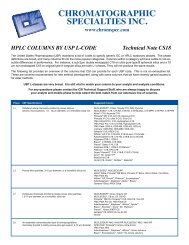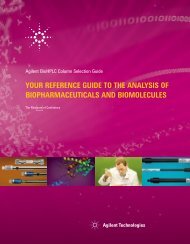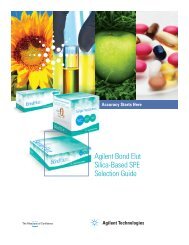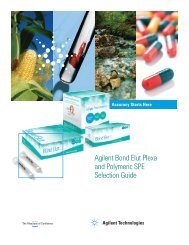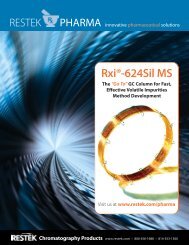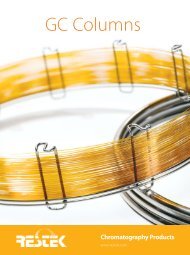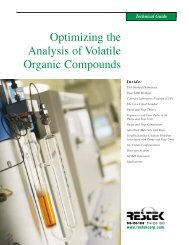Create successful ePaper yourself
Turn your PDF publications into a flip-book with our unique Google optimized e-Paper software.
Agilent PolarGel <strong>GPC</strong> <strong>columns</strong><br />
For intermediate <strong>polar</strong>ity solvents <strong>and</strong><br />
<strong>polar</strong> solvent combinations<br />
The PolarGel range is ideal for use with <strong>polar</strong> solvents, for example<br />
dimethyl formamide <strong>and</strong> dimethyl sulfoxide, <strong>and</strong> for solvent combinations<br />
such as tetrahydrofuran with water. These eluents are very useful in<br />
<strong>GPC</strong>/<strong>SEC</strong> to separate <strong>polar</strong> materials, such as <strong>polar</strong> resins, modified<br />
polysaccharides or complex <strong>polar</strong> polymers that are difficult to analyze in<br />
traditional <strong>SEC</strong> solvents, such as tetrahydrofuran alone. PolarGel-L is used<br />
for low molecular weight <strong>polar</strong> polymers <strong>and</strong> PolarGel-M for high MW<br />
<strong>polar</strong> polymers.<br />
With <strong>polar</strong> polymers, highly <strong>polar</strong> groups can lead to non-specific<br />
interactions <strong>and</strong> secondary separation mechanisms when using <strong>polar</strong><br />
solvents <strong>and</strong> traditional non-<strong>polar</strong> styrene/divinylbenzene <strong>columns</strong>.<br />
Additives <strong>and</strong>/or column conditioning are normally required to reduce<br />
these interactions. PolarGel has no need for these interventions, <strong>and</strong> also<br />
avoids the interactions <strong>and</strong> secondary effects that produce chromatogram<br />
distortions.<br />
These PolarGel “mixed bed” <strong>columns</strong> have a medium <strong>polar</strong>ity surface <strong>and</strong><br />
high mechanical stability. They are capable of operating in a wide range<br />
of solvents <strong>and</strong> solvent combinations, greatly enhancing your ability to<br />
analyze <strong>polar</strong> polymers that are not necessarily water soluble. PolarGel is<br />
available in two resolving ranges to meet your precise requirements.<br />
Charateristics<br />
PolarGel-L<br />
Particle Size: 8 µm<br />
Resolving Range (PEG/PEO in water): Up to 30,000 g/mol<br />
PolarGel-M<br />
Particle Size: 8 µm<br />
Resolving Range (PEG/PEO in water): Up to 700,000 g/mol<br />
9<br />
Conditions<br />
Columns: 2 x PolarGel-M, 300 x 7.5 mm<br />
Sample: Melamine resins<br />
Eluent: Dimethylformamide + 0.1% LiBr<br />
Flow Rate: 1.0 mL/min<br />
Temp: 50 °C<br />
Detector: PL-<strong>GPC</strong> 50 (RI)<br />
Figure 8. Superior <strong>polar</strong> performance from PolarGel <strong>columns</strong>





